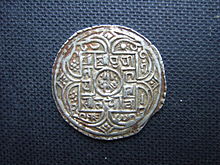
Back Indiese kalender Afrikaans تقويم هندي وطني Arabic تقويم هندى وطنى ARZ শকাব্দ Assamese Calendariu shaka AST Hind milli təqvimi Azerbaijani Індыйскі нацыянальны каляндар BE-X-OLD ভারতীয় জাতীয় বর্ষপঞ্জি Bengali/Bangla Deiziadur broadel India Breton Indický národní kalendář Czech

The Indian national calendar, called the Shaka calendar or Śaka calendar, is a solar calendar that is used alongside the Gregorian calendar by The Gazette of India, in news broadcasts by All India Radio, and in calendars and official communications issued by the Government of India.[1] Śaka Samvat is generally 78 years behind the Gregorian Calendar, except from January to March, when it is behind by 79 years.
Through historical Indian influence, the Śaka calendar is also used in Java and Bali among Indonesian Hindus. Nyepi, the "Day of Silence", is a celebration of the Śaka new year in Bali. Nepal's Nepal Sambat evolved from the Śaka calendar. The Śaka calendar was also used in several areas in the modern-day Philippines as written in the Laguna copperplate inscription. In India, Yugabda is also used with corresponding months of Śaka/Nepal Sambat. Yugabda is based on Kaliyuga Sankhya preserved by Indian Astrology. The Kali Yuga began 5,125 years ago and has 426,875 years left as of 2024 CE.[2][3][4] Kali Yuga will end in the year 428,899 CE.
- ^ "Gg Holiday Calendar". Govt. of India Official website.
- ^ Godwin, Joscelyn (2011). Atlantis and the Cycles of Time: Prophecies, Traditions, and Occult Revelations. Inner Traditions. pp. 300–301. ISBN 9781594778575.
- ^ Merriam-Webster (1999). "Merriam-Webster's Encyclopedia of World Religions". In Doniger, Wendy; Hawley, John Stratton (eds.). Merriam-Webster. Merriam-Webster, Incorporated. pp. 445 (Hinduism), 1159 (Yuga). ISBN 0877790442.
* HINDUISM: Myths of time and eternity: ... Each yuga is preceded by an intermediate "dawn" and "dusk." The Krita yuga lasts 4,000 god-years, with a dawn and dusk of 400 god-years each, or a total of 4,800 god-years; Treta a total of 3,600 god-years; Dvapara 2,400 god-years; and Kali (the current yuga) 1,200 god-years. A mahāyuga thus lasts 12,000 god-years ... Since each god-year lasts 360 human years, a mahāyuga is 4,320,000 years long in human time. Two thousand mahāyugas form one kalpa (aeon) [and pralaya], which is itself but one day in the life of Brahma, whose full life lasts 100 years; the present is the midpoint of his life. Each kalpa is followed by an equally long period of abeyance (pralaya), in which the universe is asleep. Seemingly the universe will come to an end at the end of Brahma's life, but Brahmas too are innumerable, and a new universe is reborn with each new Brahma.
* YUGA: Each yuga is progressively shorter than the preceding one, corresponding to a decline in the moral and physical state of humanity. Four such yugas (called ... after throws of an Indian game of dice) make up a mahayuga ("great yuga") ... The first yuga (Krita) was an age of perfection, lasting 1,728,000 years. The fourth and most degenerate yuga (Kali) began in 3102 BCE and will last 432,000 years. At the close of the Kali yuga, the world will be destroyed by fire and flood, to be re-created as the cycle resumes. In a partially competing vision of time, Vishnu's 10th and final AVATAR, KALKI, is described as bringing the present cosmic cycle to a close by destroying the evil forces that rule the Kali yuga and ushering in an immediate return to the idyllic Krita yuga. - ^ Gupta, S. V. (2010). "Ch. 1.2.4 Time Measurements". In Hull, Robert; Osgood, Richard M. Jr.; Parisi, Jurgen; Warlimont, Hans (eds.). Units of Measurement: Past, Present and Future. International System of Units. Springer Series in Materials Science: 122. Springer. pp. 6–8. ISBN 9783642007378.
Paraphrased: Deva day equals solar year. Deva lifespan (36,000 solar years) equals 100 360-day years, each 12 months. Mahayuga equals 12,000 Deva (divine) years (4,320,000 solar years), and is divided into 10 charnas consisting of four Yugas: Satya Yuga (4 charnas of 1,728,000 solar years), Treta Yuga (3 charnas of 1,296,000 solar years), Dvapara Yuga (2 charnas of 864,000 solar years), and Kali Yuga (1 charna of 432,000 solar years). Manvantara equals 71 Mahayugas (306,720,000 solar years). Kalpa (day of Brahma) equals an Adi Sandhya, 14 Manvantaras, and 14 Sandhya Kalas, where 1st Manvantara preceded by Adi Sandhya and each Manvantara followed by Sandhya Kala, each Sandhya lasting same duration as Satya yuga (1,728,000 solar years), during which the entire earth is submerged in water. Day of Brahma equals 1,000 Mahayugas, the same length for a night of Brahma (Bhagavad-gita 8.17). Brahma lifespan (311.04 trillion solar years) equals 100 360-day years, each 12 months. Parardha is 50 Brahma years and we are in the 2nd half of his life. After 100 years of Brahma, the universe starts with a new Brahma. We are currently in the 28th Kali yuga of the first day of the 51st year of the second Parardha in the reign of the 7th (Vaivasvata) Manu. This is the 51st year of the present Brahma and so about 155 trillion years have elapsed. The current Kali Yuga (Iron Age) began at midnight on 17/18 February 3102 BC in the proleptic Julian calendar.
© MMXXIII Rich X Search. We shall prevail. All rights reserved. Rich X Search